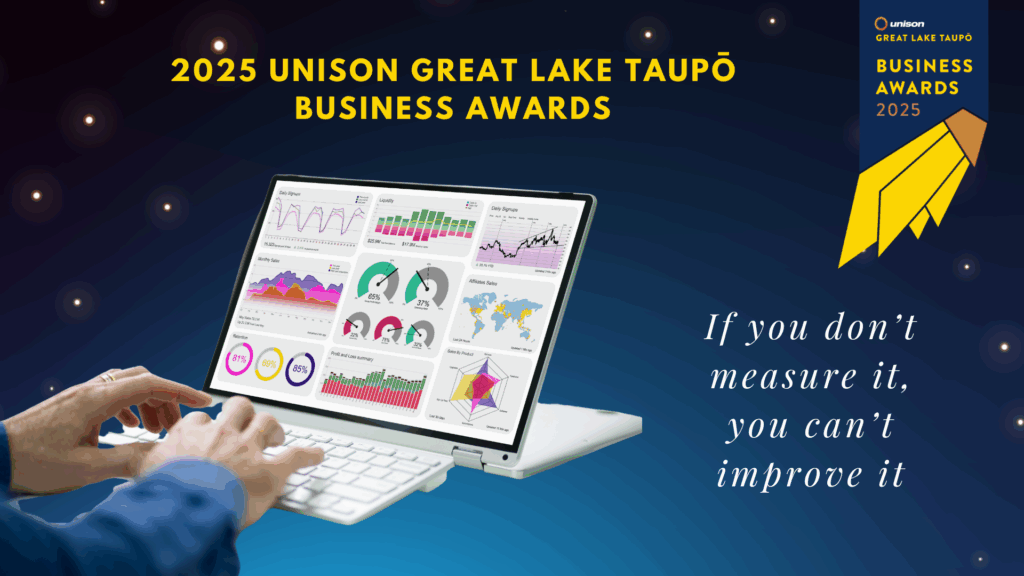
Whether you’re running a small team or leading a thriving business, setting Key Performance Indicators (KPIs) can be a game-changer. KPIs aren’t just buzzwords or tick-box exercises – they’re about giving your goals some teeth, helping your team stay focused, and making sure you’re heading in the right direction.
And if you’re planning to enter the Unison Great Lake Taupō Business Awards, having well-thought-out KPIs will not only strengthen your entry – they’ll give you the confidence to tell your story with clarity and impact.
So, what exactly are KPIs?
At their simplest, KPIs are the critical numbers that help you measure how well your business is tracking toward its goals. Think of them as your progress checkpoints. Are you moving forward? Going sideways? Or sprinting ahead?
The beauty of KPIs is that they take the guesswork out of decision-making. Instead of relying on gut feel alone, KPIs give you actual data to work with – meaning smarter choices, better performance, and fewer surprises.
Why KPIs Matter (Especially Now)
Here in Taupō, we know success doesn’t happen by chance – it takes focus, teamwork, and a bit of bold thinking. KPIs help by:
-
Clarifying what success looks like — for you, your team, and your business
-
Highlighting what’s working (and what’s not) so you can adjust your course
-
Aligning everyone behind a shared purpose
-
Building momentum by showing progress over time
Not All KPIs Are Created Equal
A good KPI is like a compass – it points you in the right direction and keeps you on track. A bad one? That’s just noise.
Here’s what to aim for:
✅ Relevant – Does it actually matter to your business goals?
✅ Measurable – Can you track it with real data?
✅ Clear – Is everyone on the same page about what it means?
✅ Actionable – Can it help drive improvement?
✅ Time-bound – Is there a timeframe attached?
The 6-Step Guide to Building Your Own KPIs
Ready to get started? Here’s a practical way to approach it — especially helpful if you’re working on your Business Awards entry or want to boost performance across the board.
1. Start with Your Business Goals
Think big picture. What are you trying to achieve this year? More customers? Higher retention? Improved staff engagement?
Choose 2–4 key goals that will really move the needle.
2. Get Specific
Once you’ve got your goals, break them down. For example:
-
Goal: Improve customer service
-
KPI: Average response time to enquiries under 2 hours
-
Goal: Increase revenue
-
KPI: 10% year-on-year growth in online bookings
3. Involve Your Team
You don’t have to do this alone! Your frontline staff often have great insights into what really matters. Bringing them into the KPI-setting process builds buy-in — and uncovers gold you might not have considered.
4. Keep It Balanced
Avoid tunnel vision. A good set of KPIs should look at:
-
Financial performance (e.g., profit margin, sales growth)
-
Customer satisfaction (e.g., NPS, repeat business)
-
Operational performance (e.g., delivery times, stock turnover)
-
People and culture (e.g., retention rates, training hours)
5. Decide How You’ll Measure
Set clear definitions for each KPI, pick your data sources, and make sure the numbers are reliable. Bonus points if you can track them easily via dashboards or reporting tools.
6. Review, Refine, Repeat
Don’t set-and-forget. KPIs should evolve as your business does. Schedule regular check-ins to see how things are going, and tweak your metrics if something’s off.
KPI Examples (Just to Get You Thinking)
| Focus Area | KPI Example |
|---|---|
| Sales | Conversion rate of enquiries to bookings |
| Customer Service | Net Promoter Score (NPS) over 50 |
| Operations | 95% of orders dispatched within 24 hours |
| Team Engagement | Monthly team satisfaction survey score >8 |
| Sustainability | 20% reduction in single-use plastics by year-end |
Final Thought
Whether you’re entering the Business Awards or just want to grow stronger year on year, having the right KPIs in place is like giving your business a roadmap and a rear-view mirror – clarity on where you’re going, and a way to reflect on how far you’ve come.
And remember – the process of setting KPIs doesn’t have to be scary. Done right, it’s empowering, insightful, and even fun. Especially when the whole team’s involved.
So… what will your key indicators of success be this year?

































